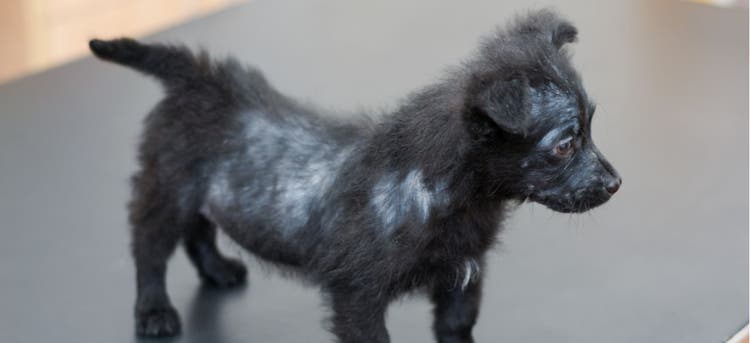
Hair Loss (Alopecia) in Dogs
Excessive hair loss resulting in bald spots (alopecia) can lead to a very striking change in your pet’s appearance. Alopecia can be a cosmetic issue or, in some cases, a sign of an underlying hormonal or health problem. Many diseases that cause hair loss have similar symptoms, so your veterinarian may need to do several superficial tests on the affected areas and possible blood work to pinpoint what is triggering the condition.
Causes of Hair Loss in Dogs
Follicular Dysplasia
Several breeds have congenital (inherited) hair follicle abnormalities that result in alopecia. These breeds include:
- Chesapeake Bay Retriever
- Irish Water Spaniel
- Portugese Water Dog
- Siberian Husky
- Alaskan Malamute
Unfortunately, since they are genetic at base, there are no known treatments for these types of alopecia. Chesapeake Bay Retrievers are affected by an inherited alopecia and will begin losing hair early in life, usually between 1 – 4 years of age. Their normal coat will slowly degenerate into patchy bald spots on the trunk and thighs. Irish Water Spaniels have congenital hair follicle issues resulting in hair loss on the neck, rump region, and, occasionally, the caudal thighs. Hair loss is seen earlier in females than males in this breed. In addition to hair loss and bald spots, the remaining hair is coarse and wiry compared to the normal hair coat.
Portuguese Water Dogs are affected by a congenital change that usually begins with hair loss around two years of age. It is most commonly seen on their dorsum and flanks, but can occasionally affect areas around the eyes or thighs. Hair loss is typically cyclic with periods of spontaneous regrowth. However, the regrown hairs are abnormal in texture and appearance.
Siberian Huskies and Alaskan Malamutes have a different type of follicular abnormality than the aforementioned dog breeds. The plush coats of these Northern breeds are prone to hair cycle arrest (delay of hair growth cycle). This can be spontaneous, but is often seen after clipping the hair.
Pattern Baldness
Just like humans, dogs can experience pattern baldness as they age. This type of alopecia results in non-inflammatory, progressive hair loss on the ear flaps, ventral neck, chest, ventral abdomen, and thighs. Unlike humans, this type of hair loss can be seen in both sexes, with females being more prone. In some cases, baldness will be localized in one region, but some dogs will have hair loss affecting all of the areas listed above. Breeds that are more commonly affected by pattern baldness are Dachshunds, Chihuahuas, Miniature Pinschers, Whippets, Greyhounds, Italian Greyhounds, Boston Terriers, and Boxers.
Just like in human medicine, there is no effective cure for pattern baldness in dogs.
Color Dilution Alopecia and Black Hair Follicular Dysplasia
Color dilution alopecia targets hair that is blue, gray, fawn, or red. This will typically result in breakage and loss of hair before 1 year of age. In dogs that have mixed hair coats, hair loss will only affect the dilute-colored hair.
Chihuahuas, Chow Chows, Dachshunds, Doberman Pinschers, Great Danes, Italian Greyhounds, Salukis, and Whippets are some of the most commonly affected breeds. Weimaraner and silver Labrador Retrievers have dilute natural coat colors, making them prone to this condition.
Black hair follicular dysplasia specifically affects black hair and results from a true abnormality in the formation of the follicles. Hair loss is also noted early in life, often within the first few months. This condition has been noted in numerous breeds including Bearded Collies, Doberman Pinschers, Salukis, Border Collies, King Charles Spaniel, Jack Russell Terriers, and Gordon Setters.
Like other congenital follicular disorders, there is no cure for either color dilution alopecia or black hair follicular dysplasia. However, management is focused on decreasing secondary signs, like bacterial infections and scaling, with shampoos and topicals.
Alopecia X
Alopecia X is thought to be caused by an imbalance in the sex hormone pathway. Since a variety of hormones affect the hair cycle, imbalances can result in hair loss and alopecia. This type of hair loss typically starts between 1 – 3 years of age, but can occur at any time throughout an animal’s life. In addition to hair loss, the remaining coat is usually coarser and thinner than normal. The skin associated with hair loss may be darker (hyperpigmented) and scaly.
Pomeranians are the breed most affected by this syndrome. However, other plush-coated breeds like Chow Chows, Keeshonds, Alaskan Malamutes, Siberian Huskies, and Samoyeds are overrepresented. This is a primarily cosmetic disease, but treatment with different supplements or medications to regulate hormones may be helpful.
As previously mentioned, many of these hair loss disorders are inherited and not curable, however, biopsies are often recommended to confirm the cause of hair loss. Additionally, when hair follicles are abnormal, your dog’s skin may be more prone to bacterial follicular infections (folliculitis), which can cause additional skin changes and will need to be treated. Although hair loss is cosmetic, it can be distressing for owners and should never be ignored. If your dog is developing bald patches, it is definitely worth a trip to the veterinarian to determine the issue.